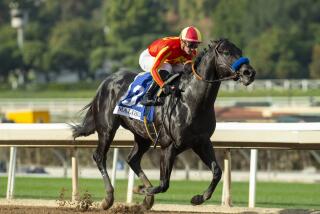AMERICA’S CUP ’92 : Winds Chart a Course Toward Confusion : Sailing: Conditions for America’s Cup race committee to scramble to alter the course.
SAN DIEGO — The America’s Cup race management weathered a sucker punch Wednesday, trying to match the course to a sudden, erratic Santa Ana condition that sprang up in the morning.
Terry Harper called the weather, and the problems it created, among the more unusual he’s seen in San Diego. He speaks from experience: Harper, vice president of race management for the America’s Cup Organizing Committee, has been involved in competitive yachting more than 20 years.
How many days had he seen like this in two previous decades? “None,” he said with a tight smile.
On the second day of the Defender Selection Series, Harper and representatives of the two syndicates sailing Wednesday huddled and agreed to move the start three miles west of the original spot to deal with the gusts unexpectedly coming out of the northeast.
Then with the race under way, the wind calmed while shifting 210 degrees, and Harper’s committee hurriedly changed the third leg of the eight-leg course, which includes an S in the middle.
The bizarre weather turned what were supposed to be downwind legs upwind, and vice versa, and kept the race committee and sailors guessing. Dennis Conner’s Stars & Stripes dealt with it better early on, taking an early lead and defeating Bill Koch’s Jayhawk in a breeze.
Stars & Stripes tactician Tom Whidden called conditions “very fluky.” He added, “If you looked inshore and offshore, boats were going in every direction. So it was confusing. It was a pretty tricky day out there.”
The Jayhawk’s tactician, Andreas Josenhans, noted, “The wind had our full attention. I think we saw 25 or 26 knots about 30 minutes before the gun.”
The race committee uses a private high-tech firm to monitor weather conditions before deciding the course, and Wednesday’s anticipated conditions called for calm seas with breezes of five to seven knots.
Instead, they got a howling northeast wind of 15 to 18 knots and choppy seas. “I thought we were talking to the right person on the weather,” Harper said. “We got something we didn’t expect.”
For that matter, Harper said, it was even tough deciding which direction the wind was taking.
“The committee has boats that take readings all over the course, and different boats continue to feed information,” Harper said. “Today it was a little difficult--we were getting shifting individual readings (differing) up to 50 to 60 degrees at any moment.
“It started out of the east, a mild Santa Ana. Then it literally rotated out to the southwest, then we got a blast from La Jolla (northeast). It was very unusual.”
Harper’s challenges also included moving the course marks, which gets more difficult the farther they’re set from shore.
However, Harper said postponing or abandoning the race was never discussed. “The consultation (with syndicate representatives) was not about abandonment at any time,” he said. “There was discussion of postponing the start. We felt it was appropriate for the race to proceed. Abandonment for wind condition is usually the responsibility of the sailors.”
Josenhans said, “It was an interesting race course. At one point we thought we were on one leg when we were on another leg. The crew was confused.”
For Harper and the race committee, at least, things went as smoothly as could have been hoped, as they did for Stars and Stripes.
Whidden said, “Our hat’s off to the race committee for even keeping up with it.”


